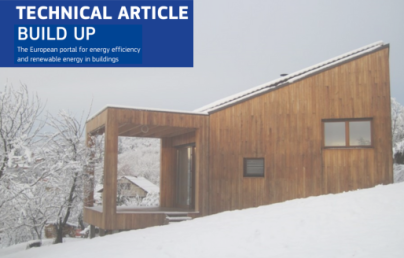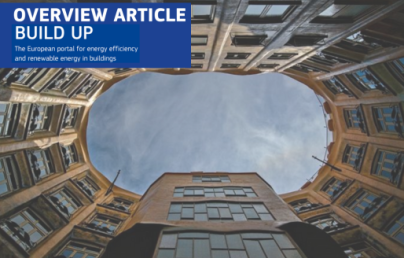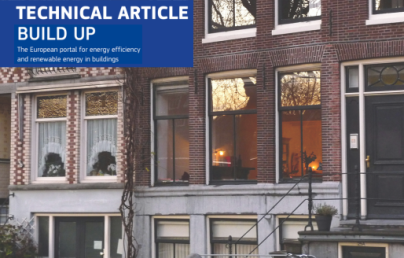OVERVIEW | Decarbonising the non-residential building stock

OVERVIEW | Decarbonising the non-residential building stock
The building stock in the EU Member States is relatively old, on average 21.6% of the building stock was built before 1945, 45.4% was built before 1969 and 75.4% before 1990. With the exception of Cyprus, Ireland, and Luxembourg, the proportion of residential building stock built after 2000 is below 25%. A relatively old building stock means that without significant investments to improve the energy performance, the average level of energy performance of the national stock will remain low.
Even if all new buildings will be nearly-zero energy buildings, due to the fact that buildings are assets with a long lifetime, at current renovation rates it will take over 100 years to renovate the entire EU building stock.
Whilst the improvement of residential buildings can generate many benefits in terms of energy and GHG savings, the non-residential sector includes building typologies that require significant energy consumption. The non-residential sector needs urgent and insightful interventions to move toward to a real decarbonisation of the whole building stock. Current strategies are focused in moving from the current building market segmentation to a new green market that increases the investment and impacts in policy making. There needs to be a change from the current one-size-fits-all approach to specific consideration of building typologies.
A clear categorization provided by Annex I of the Energy Performance of Buildings Directive 2010/31/EU, identifies the following typologies; single-family houses (of different types), apartment blocks, offices, educational buildings, hospitals, hotels and restaurants, sports facilities, wholesale and retail trade service buildings, and other types of energy-consuming buildings.
The European Buildings under the Microscope, Buildings Performance Institute Europe (BPIE) report screens all EU27 countries with Switzerland and Norway with the aim of collecting existing data related to buildings and building policies. The dataset has been used to provide an overview of the energy performance of buildings based on the typology, characteristics (such as age, size, and ownership profile) and energy performance of the building stock of the countries. This is one of the most comprehensive European data collections and includes residential and non-residential buildings.
The non-residential sector contains a wide range of diverse typologies. This includes wholesale & retail (28% of the total), offices (23%), educational (17%), hotels & restaurants (11%), hospitals (7%), sport facilities (4%), and other buildings (11%) such as warehousing, transportation and garage buildings, agricultural (farms, greenhouses) buildings, garden buildings. This extensive assortment of typologies represents highly complex patterns of energy use within the sector because end-uses such as lighting, ventilation, heating, cooling, refrigeration, IT equipment and appliances vary greatly from one building category to another and from one country to another.
Based on the BPIE data, the average specific energy consumption in the non-residential sector is 280kWh/m2 (covering all end-uses), which is at least 40% greater than the equivalent value for the residential sector.
The most energy intensive typologies in specific terms are represented by hospitals that tend to be at the top of the scale with continuous occupancy and high-energy intensity levels, even though their overall contribution to the total non-residential consumption is small. This is also the case with hotels & restaurants, while offices, wholesale & retail trade buildings on the other hand represent more than 50% of the total energy use of this sector. Education and sports facilities account for a further 18% of the energy use while ‘other’ buildings account for 6%.
Research by the Energy Efficiency Financial Institutions Group (EFFIG) carried out in 2015, analysed the drivers for investment in residential, public and commercial buildings (such as shopping centres, offices, restaurants, hotels, hospitals, garages and stores). This underlined how specific measures are required for specific segments. In commercial buildings, the key role is represented by decision makers and sector leaders with a clear business case to increase their confidence and understanding of the risks, supported by strong measurement, verification and reporting protocols and quality assurance. Public buildings renovation should be facilitated through technical assistance to relevant public sector bodies to ensure that the energy savings and other multiple benefits are properly reflected and that balance sheet debt restrictions do not prohibit public authorities from refurbishing buildings. Finally, renovation of residential buildings can be facilitated by simple, easily accessible, low interest rate, tax beneficial retail energy efficiency financing offers that should be marketed widely through various trusted retail channels. EEFIG members collectively reported that the main barrier to investment in energy efficiency in the residential sector is related to individual payment capacities.
Encouraging investment and accelerating movement towards a nearly zero energy non-residential building stock across the EU is the aim of the Horizon 2020 ALDREN project. This intends to consolidate, promote and implement an extended harmonized procedure, based on the European Common Voluntary Certification Scheme for non-residential buildings EVCS, and a set of relevant instruments in order to support building deep renovation operations in hotels and offices. To boost the investment, currently insufficient to deliver on the Union’s climate change and energy objectives for 2030, the ALDREN project will set a framework to explicitly establish the link between the certified energy (or sustainable performance) and the risk assessment. This includes the value of the property or the credit risk for the finance provider, and it will define how, beyond the expected energy savings, the sustainability and energy features of buildings can be translated into economic value.
With regard to public buildings, the Horizon 2020 EmBuild project supported public authorities in Southeast European countries to prepare a long-term strategy for mobilising investment in energy efficient renovation of the public building stock. The main objective was to empower public authorities at the local, regional and national levels to formulate renovation strategies for the building sector that foster deep renovation and facilitate the acceleration of the renovation rate. EmBuild has developed a Navigator, namely a guidance with practical information on the steps of preparing a renovation strategy, including the following three pillars;
-The plan phase is intended to include the renovation strategy itself and the process behind its development. This phase includes the creation of a stakeholder network, a catalogue of successful examples of building stock appraisals, a structured questionnaire for conducting a preliminary analysis, a standardised report that includes relevant parameters and guidelines for the calculation of costs and profitability of various measures. All the involved stakeholders must have been trained and informed through webinar and technical sessions.
-The invest phase is when local governments move from intentions towards a proven ability to attract and introduce capital investment in the municipal budget and execute it. This phase contains a database of existing and innovative best-practice examples facilitating and stimulating the application of energy efficiency measures in public buildings for the active involvement of stakeholders at public level.
-The benefit phase includes the investigation and identification of, cost-benefit assessments, synergies and mutual interaction between wider benefits beyond energy savings, and to help local governments disseminate the outputs and outcomes of their deep renovation strategy.
Beyond the potential savings in energy and money, wider benefits can be gained by the renovation of multi-stakeholder buildings. The Building 4 People reports, based on more than 400 academic articles, dozens of case studies and expert interviews, has taken an important step in the analysis of the impacts related to wellbeing and indoor environmental quality in schools, hospitals and offices. These reports have identified many positive consequences in terms of improvements in health and wellbeing and enhanced productivity of employees.
The most important aspect to be taken into account is the key role that the public sector, real estate developers, investors and planners can play is that through leading by example raises standards and influences other players toward a real decarbonized, comfortable and healthier building stock.


